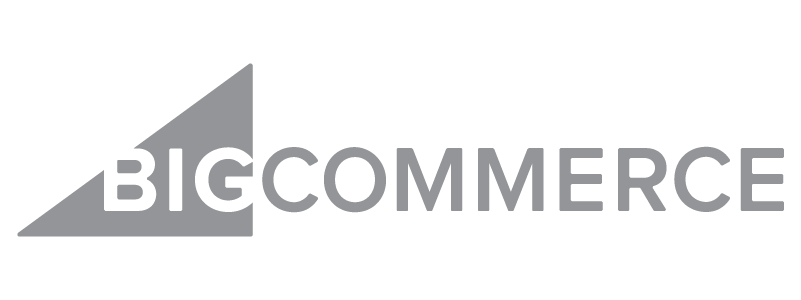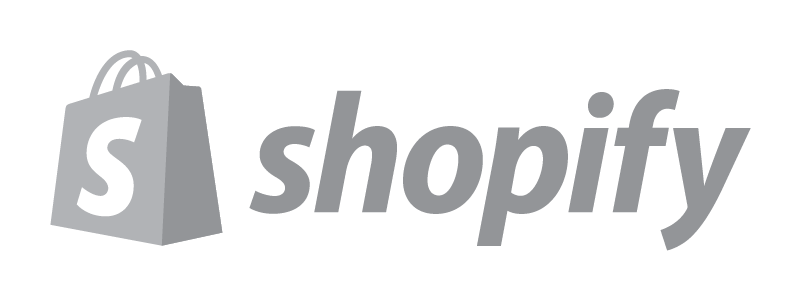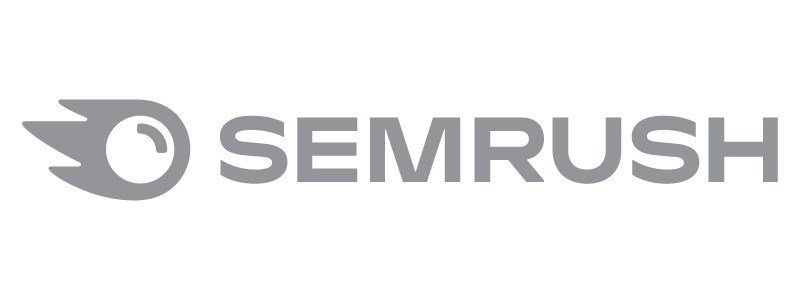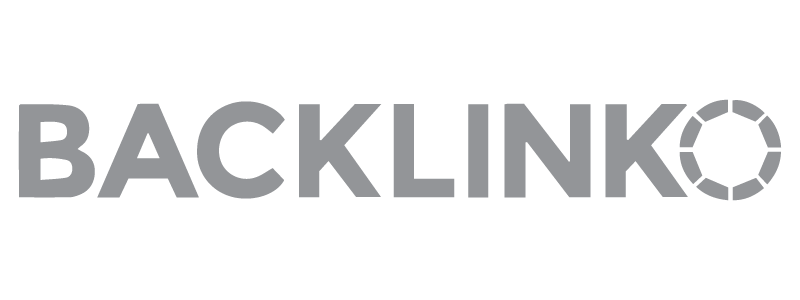Shopify is among the most popular tools for building your ecommerce website, and with good reason.
It’s user-friendly which is great for the novice ecommerce entrepreneur, has a wide range of templates to choose from, and provides flexibility for use with multiple business models. Looking at the marketing materials alone, it’s easy to see why many users jump right in.
Finding the right ecommerce tool for your needs is crucial to your success, but relying solely on a provider’s marketing isn’t the best way to get the job done. Our Objective Shopify review will give you a real look at what you can expect. Plenty of reviews I’ve read just give five stars to the highest bidder.
Yes, it’s true we get affiliates, but they don’t influence the scores. With my rating system, there’s no possible way for platforms to change their score. Our ratings are as objective as possible, based on data.
Why? Because I know how hard it is to understand the nuances of one platform to the next. If you invest time and money on one platform, only to discover it’s not going to work for you, changing to another option is nobody’s idea of fun.
So, does Shopify live up to the hype of being an all-in-one ecommerce solution? Keep reading this Shopify product review to find out.
There are dozens of ecommerce carts to choose from, but Shopify is a name that frequently shows up in lists of the best ecommerce website builders. For those who aren’t familiar with this cart, questions like “what is Shopify?” and “How does Shopify work?” are common.
Shopify Overview

Shopify has positioned itself as one of the most popular hosted ecommerce platforms on the market today, and with good reason. As it’s cloud-based, you can access it from anywhere an internet connection is available – and you don’t have to shell out extra cash for web hosting. As an all-inclusive online selling platform, it has everything you need to start selling products to customers, including SSL site security. It’s best suited for dropshipping businesses and small boutiques. The more inventory you have to manage, the more complex and expensive it becomes.
Shopify History
Shopify first began in 2004, when software engineer Tobias Lutke wanted to open an ecommerce store to sell snowboards from third parties. Though he didn’t want to be a software engineer anymore, he was disappointed in what he found on the market, so he partnered with other programs and launched Shopify to the public in 2006. Initially, the platform helped merchants with customizable templates, uploading images, tracking orders, grouping items in categories, and accepting payments with PayPal or a payment processor integration.
By 2013, they added the point-of-sale (POS) system you can use inside your brick-and-mortar store if you have one. A Shopify retail package is available for an additional fee. It includes the necessary hardware and a staff management feature.
Now, it’s possible to add a Buy button to sell things from any website – not just their ecommerce platform. With this and Shopify QR codes, there’s no longer a gap between online and offline sales, and business owners have a central location to manage it all.
Shopify Pros and Cons
Overall, Shopify is a fantastic platform. When it comes to performance and theme design, Shopify is the best of the best. The user interface is simple and intuitive. You can be up and running over a weekend. If you want to do a lot of customization, you’ll need a developer or agency to help you, though. Also, if your sole growth engine is SEO, you probably should think twice. While you can rank a Shopify site, it isn’t the best platform for SEO.
Shopify Pros
Shopify Cons
Is Shopify Right for Your Ecommerce Business?
If all you need is a basic store, Shopify is an excellent choice. It loads quickly and is simple to set up. Once you sign up for your account, all you have to do is follow the on-screen instructions to build your store (here are popular Shopify stores). Thanks to the extensive library of free and paid themes, you can find a style that fits your brand with relative ease. There are plenty of certified partners available to help you if you cannot find the time to do it yourself. The one-click selling and social media selling features make it easy to get things up and running.
Are you a business owner who wants to increase revenue without getting caught up in administrative tasks? Are you less than savvy when it comes to technology? Shopify is the best option for people who don’t want to deal with the technical aspects of running an online business. It even includes a blogging platform so that you can share news and updates with your customers without the need for a separate platform.
However, multiple studies show it rates poorly when it comes to search engine optimization (SEO). For up-and-coming brands who need to build a presence in the search engines for a source of potential customers, it can be an uphill battle. The fact that Shopify sticks things like /collections/ in the URL really limits your information architecture. Yes, there’s always pay-per-click advertising, but this can add up, putting a serious squeeze on any budget.
Shopify Development and Technology
While there’s an extensive app and integration library to add more features to your store or make things easier for you to manage, many of them come with additional monthly fees. Using a few of them together can dramatically increase your monthly costs.
If you require advanced customization or features for your Shopify store, you’ll need to hire a developer to handle it for you. The page-building app, Shogun, can give you a bit of freedom and flexibility to customize your store. Still, for any long-term site maintenance or custom functionality, experienced developers are the best.
Shopify is built with the Ruby on Rails framework, and the platform isn’t designed to let users do a lot of work themselves. The more complex your store needs are, the less likely Shopify is the right platform for your needs.
If one of the biggest advantages you’re looking for is the ability to customize your checkout process, you may need to rethink using Shopify. While you can add your logo, change the colors, or change the font, there’s nothing else you can do to your shopping cart and checkout pages. Without a custom checkout app, you won’t be able to make adjustments based on split tests or integrate your customer relationship management (CRM) software.
You won’t be able to create upsells, cross-sells, thank you pages, or simplify the process with a one-page checkout. I think a customizable checkout process is crucial to your Shopify marketing efforts, so I hope that Shopify will eventually make it possible for users without the need for third-party apps.
Businesses Powered By Shopify
Shopify continues to grow, with millions of businesses relying on it to run their operations. Brands and online stores that are powered by Shopify include:
For many entrepreneurs, Shopify’s platform is worth the extra investment. It gives industry leaders like BigCommerce and Volusion tough competition but remains focused on the store owner and keeping things easy to operate. If it’s good enough for both up-and-coming and major brands, it clearly offers value. But what works for those companies may not work for you. Let’s look at how it compares to other major platforms.
Shopify POS
One of Shopify’s differentiating factors is its POS system, which you can use in person. Having a solid POS system is an essential part of running a brick-and-mortar store, and Shopify has got you covered. With the ability to use Shopify’s POS system in person, it’s perfect for those businesses that have both online and physical storefronts. It’s easy to use and integrates seamlessly with your online store inventory, making it easy to track sales across all channels. If you’re looking for a reliable and efficient POS system, Shopify is definitely worth considering.
Shopify Comparisons
Software as a Service (SaaS) is any software hosted on the cloud and delivered with a subscription model, such as Shopify, BigCommerce, and Wix. Users don’t have to install anything on their computer. The provider maintains everything for the users, who pay a subscription fee based on service level. That translates to fewer technical details for shop owners to deal with, but it also limits the ability to edit the source code for customization purposes. With SaaS, you’re getting something ready to go out of the box. All you have to do is attach your domain name, select your theme, and add your content.
However, open-source solutions like WooCommerce allow users to view, edit, and distribute the source code for their own purposes. Ultimately, development is public and collaborative. If there’s a feature you’re missing, you can either build it yourself or hire someone to build it for you. With open-source, you’re essentially starting from scratch.
Should you go with a SaaS ecommerce platform or open-source ecommerce software? The short answer: It depends.
SaaS solutions are the ideal choice for:
- Tech novices who want something easy to use.
- People who don’t need any special features or functionality.
- Those who want a set-it-and-forget approach.
- Users who want some freedom and flexibility in terms of marketing tools, apps, widgets, and extensions.
- Startups and businesses in the early stages of growth where the IT budget is limited.
Even though open-source options are free, you need more than the software to run your store. You’ll have to invest in web hosting and SSL, which may or may not include a free domain name. There are a few companies that allow you to pay monthly, but most of them require annual payments. And if something goes wrong, it’s on you to fix it. If you’re not familiar with web development, you’ll need to hire someone to address the issues for you, which could easily become more costly than your SaaS ecommerce solution subscription fees.
Open-source ecommerce platforms are best for:
- Customers who need more control over their development roadmap because of multiple integrations or unique products.
- Users who don’t want to pay fees every month and share profit per sale.
- Those who understand the importance of owning hosting and customer data.
- Those who want the freedom to choose their own hosting provider – either on-premises or a managed solution for PCI compliance and 24/7 support.
- Those who want more control over their customer experience for a competitive advantage.
Using open-source software allows you to list the integrations and features you want to add to your website, and your in-house development team or partner agency uses the open-source modules as the basis for the customizations and tools you need. Only the features and integrations you need are used and released according to the schedule you plan. You’ll be able to release security updates on your own schedule instead of waiting for your provider to do it.
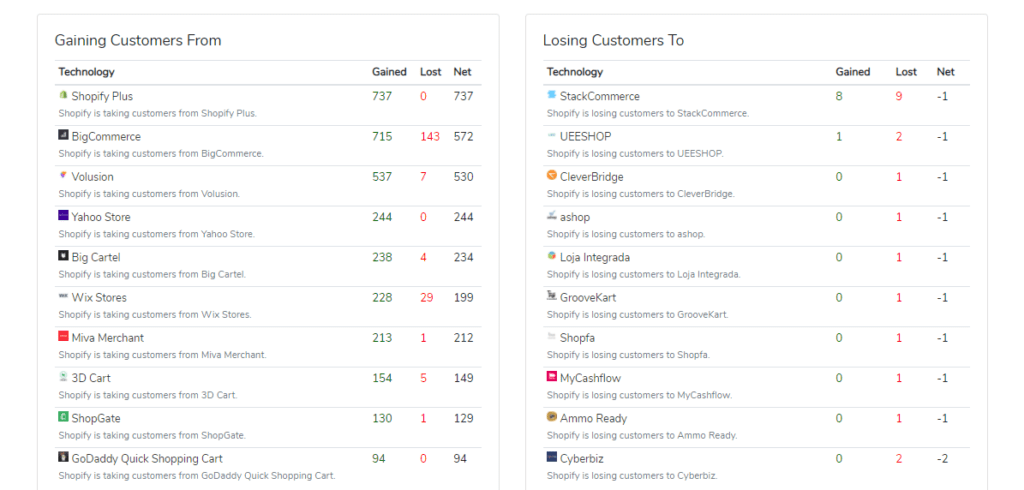
Shopify powers more than 3,500,000 websites, with the majority of those in the United States. Statistics show customers switch from other providers, like Volusion, Yahoo Store, Big Cartel, and Wix. They are the most popular hosted solution in the top 10,000 sites in the hosted solution category.
Shopify Comparisons
- BigCommerce Vs Shopify: Comparing The Best Hosted Ecommerce Software
- Shopify vs Squarespace: A Data-Driven Comparison Guide
- WooCommerce vs Shopify: Which One Should You Go With?
- Shopify vs Weebly: Which One is Best for Building Ecommerce Sites?
- Shopify vs. Wix: Which One is the Better Choice?
Shopify Pricing and Plans
Price is an area where Shopify is definitely not a winner. You’ll pay anywhere from $29 to $299 per month, and that doesn’t include advanced marketing features such as recurring billing, smart product search, or eBay integration. For that, you’ll pay even more on top of Shopify’s monthly fees.
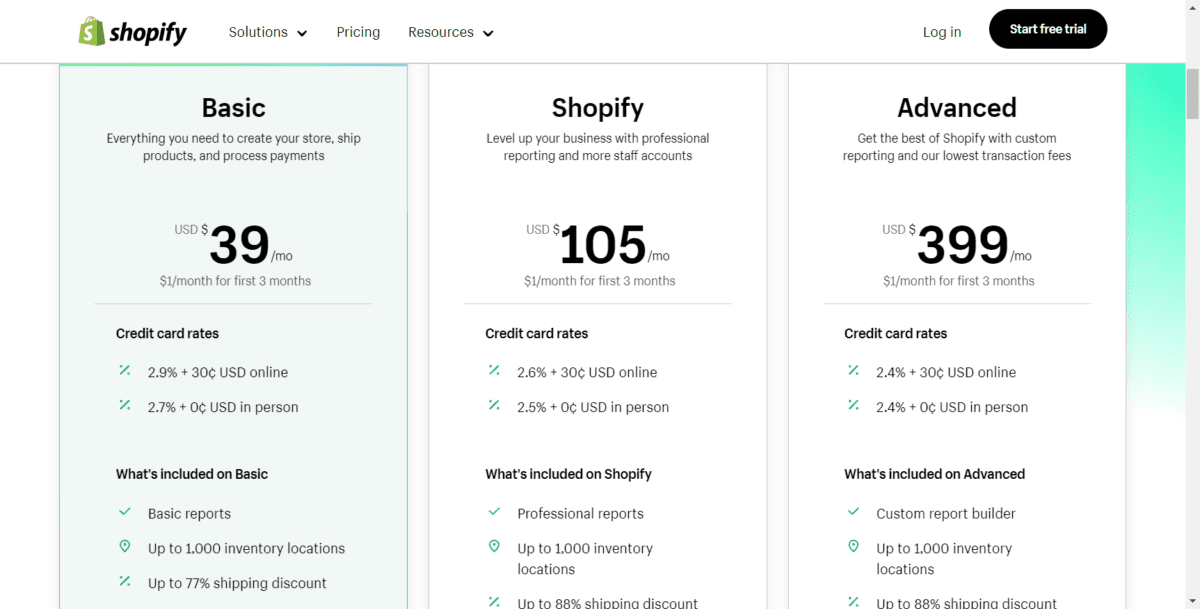
Don’t fall into the trap of the Shopify ‘Lite’ plan, thinking you can operate a mini-store. With this plan, you can set up a Facebook store, use your Shopify account to sell offline, manage inventory, or use Shopify buttons on your site. This plan, at $9/month, allows you to add Buy buttons to any website and accept credit card payments in-person and create invoices for custom orders. It is the ideal choice for people who do not want to operate a full storefront but want to be able to sell products and services from an existing website built on another platform like WordPress. Think of this like the PayPal Buy Now button.
What you’ll pay for the Shopify website builder varies on a variety of factors. At first glance, the plans seem fairly simple, but after you consider all the additional costs associated with plugins and marketing software, you’ll soon realize it can get really complicated.
Translation: Don’t choose your Shopify plan on price alone. For the plan to be worth it, it has to have the features and tools that effectively support business growth and expansion. Understanding what each tier offers not only ensures you don’t pay for more than you need but that you know when it’s time to upgrade as you scale.
If you want to save some money, commit to one year for a 10% discount or two years for a 20% discount when paid upfront. You’ll be able to use the free trial before deciding what you want to commit to.
Don’t get me wrong, each Shopify offering is enticing in its own right, but certain options will be better for your business. The best way to narrow it down is to look at the key features that come with each tier and match it to your business needs.
That said, you also need to consider your budget to make sure you can afford the payment – either every month or annually. There’s always the option to downgrade, but if that means losing core features you need to run things smoothly, it could do more harm than good.
Which Shopify plan is right for you?
I’ve done all the research, so you don’t have to. All the pricing tiers include essential features such as an online store and blogging features, with unlimited products, SSL certificates, and 24/7 support. The Shopify POS Lite is included in all plans for free, with the option to upgrade to the Pro pricing plan for an additional $89/month/location. There are no setup fees. If you have more money to spend upfront, you can opt for the annual plan rather than the monthly plan, which is typically discounted. Note that any credit card processing fees Shopify charges won’t be returned if you refund a customer. If your business has a liberal return policy, factor this into your decision to use Shopify in favor of another ecommerce solution.
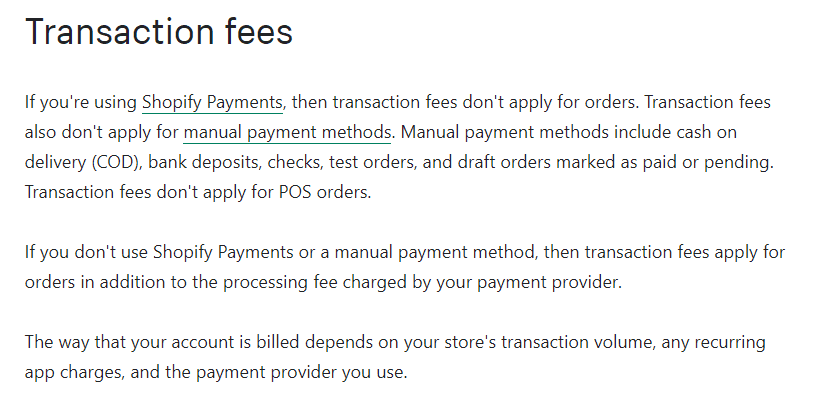
Shopify Starter: $5/month
The Shopify Starter plan is the easiest plan and cheapest option for those who want something quick, affordable, and hassle-free. With Shopify Starter, you get a 3-day free trial, after which you start paying a measly $5 monthly price. This plan is an option for newcomers just looking for basic functionality to start a site quickly, then sell through social media, automated email, SMS, WhatsApp, or anywhere else you can share a link to your product.
Shopify Basic: $39/month
With the Shopify Basic plan, you’ll get extra functionality with two staff accounts, up to four locations, shipping discounts (up to 64%), the option to print shipping labels, and fraud analysis. You’ll pay 2.9% + 30 cents as a transaction fee for each online credit card transaction. That rate decreases to 2.7% for in-person credit card transactions.
If you use any other payment gateway besides Shopify Payments, you’ll pay an additional 2.0% in fees. This is best for those who are just testing the e-commerce waters. It works well for both physical and digital products. The inclusion of Gift Card support is temporarily available on all plans as a result of COVID-19.
Shopify: $105/month
With this plan, you’ll get everything in the basic plan. Instead of two staff accounts, you’ll get five and up to five locations. You’ll get professional reports and up to 72% off shipping options from USPS, UPS, or DHL Express. The big difference in the plans is that you’ll get USPS Priority Mail Cubic pricing and a reduced transaction fee.
Under this plan, you’ll pay 2.6% +3 0 cents per transaction for online credit card transactions, 2.5% for in-person transactions, and only 1.0% in fees for payment processors other than Shopify Payments. This plan is best for experienced ecommerce merchants who want to save a bit on transaction fees and need additional staff accounts or store locations. If you want reporting features to keep a closer eye on your key metrics like financial health and customer demographics, you’ll want this Shopify plan. If you want more, you’ll want Advanced Shopify.
Advanced Shopify: $399/month
Under the Advanced Shopify plan, you’ll get everything in the middle-tier plan, with 15 staff accounts, up to eight locations, an advanced report building, and third-party calculated shipping rates. Your shipping discount increases slightly to up to 74% off. Your credit card rates decrease to 2.4% + 30 cents per transaction and 0.5% in fees for payment gateway processors other than Shopify Payments.
Advanced Shopify is best for larger ecommerce outfits with multiple retail store locations. It offers the flexibility to build advanced custom reports along with the ability to show calculated shipping rates at checkout.
Shopify Plus: Custom Plan and Pricing
Shopify Plus is best for enterprises and what brands like Staples and Heinz use. To use the Shopify Plus plan, you’ll have to contact Shopify to discuss your needs for a quote. Expect the fees to start at around $2,000 per month. What do you get for the minimum $ 1,700-a-month price increase?
- A Shopify 24-hour support team with priority-level support
- Access to a community forum
- Two additional clone storefronts for globalization purposes
- Better access to support for your development team for customization purposes
Check out this more detailed post on Shopify pricing if you want more information about your options and where the expensive plans are right for your business.
Shopify Features
All Shopify plans, with the exception of Shopify Lite, include unlimited products and bandwidth, POS, fraud analysis, and staff accounts. Those are great, but for success, you need more for your online store. Shopify’s dashboard makes it easy to get your website up and running over the course of a weekend, but it pays to spend a bit of time on certain areas of functionality.
Shopify Features and Plans
Basic SEO Tools That Are Sometimes Problematic
Shopify automatically generates an XML sitemap and robots.txt file for you, along with canonical URL tags. You also have the ability to provide title tags, meta descriptions, and ALT tags. Recently, the e-commerce site builder made some changes to the URL structure option, but overall, I feel like they’re too rigid. I’ve noticed by the beat ranking performance for Shopify sites and lower than what I’d like to see.
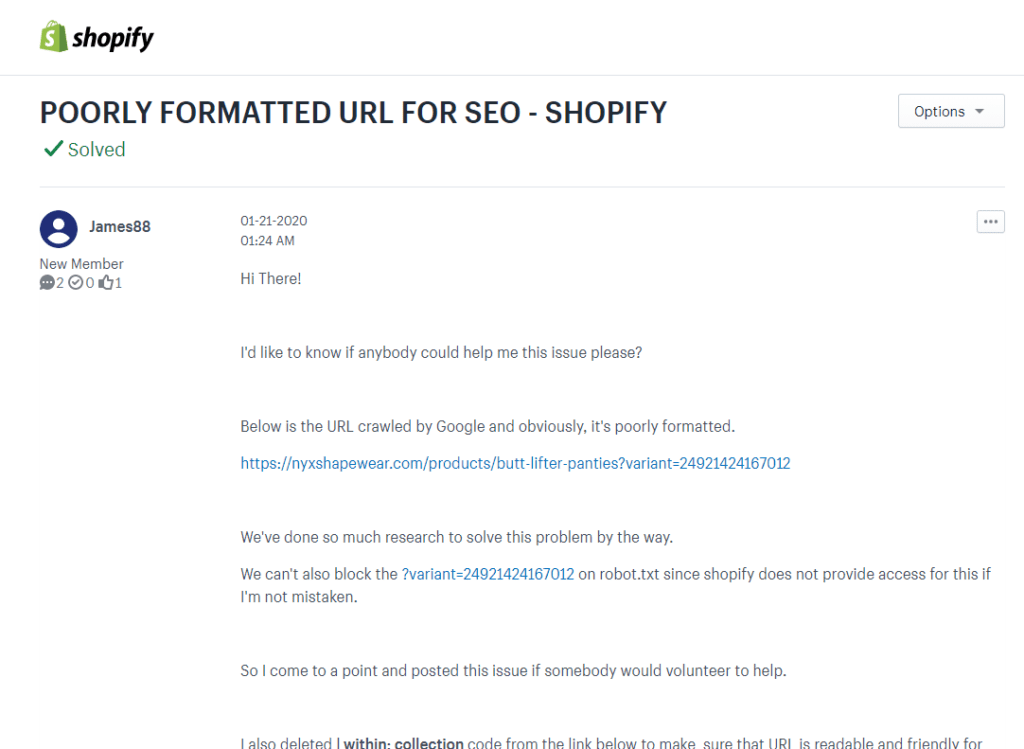
That said, the fact that Shopify includes a built-in content management system is a major selling point since blog posts can be such a valuable source of traffic and helpful for a content marketing strategy. The blog feature allows you to create content separate from your products, change author information, categorize posts, and adjust the meta description. If you’re familiar with WordPress, you’ll find that the interface isn’t as intuitive.
Thinking about using a WordPress blog with your Shopify site because you want something that’s content-heavy? It could easily become a technical nightmare. You’ll have to install WordPress on a separate subdomain for it to work – which also means two separate logins to keep track of… and another element of your site to keep secure.
While Shopify handles site security for you, you’re on your own for securing your WordPress installation. While there are plenty of plugins available to help with this, many of them are premium and require a one-time or monthly subscription fee.
If you need more advanced SEO features, you can turn to the Shopify App marketplace for help. Premium apps can help you with adding schema markup to your products, detect broken links, compress images, and more.
Schema markup makes it easier for your products to show in Google search results with rich snippets that provide information about the product, including its rating and product. Broken links are bad for the customer experience and, when left alone for too long, can affect your ranking. Image compression is helpful in improving page speed.
Shopify covers the basics of SEO, but it’s not enough to give you a real competitive advantage. If you’re in a particularly saturated niche where there is a lot of competition, expect to go the extra mile for optimization.
Landing Page Builder Will Cost More
While it’s true that technically any page on your website can be a landing page where the customer first lands on your site, in terms of marketing and sales, landing pages are specific and different from the rest of the pages on your website.
A landing page is a stand-alone page that has the goal of getting a certain type of visitor to take a single desired action. Why do you need ecommerce landing pages? A Marketing Charts study revealed:
- Product page visitors at 42% fewer pages compared to post-click landing page visitors.
- Product pages convert nearly half as many visitors as compared to post-click landing pages.
- Revenue per session for product pages is about half compared to post-click landing pages.
When you consider that only a small percentage of consumers will actually purchase from you, landing pages need to be an essential part of your marketing plan. They are more effective at getting customers to purchase compared to a standard product page because of their highly focused nature.
It’s common to see landing pages used in paid advertising campaigns because they help keep customers on your site longer and facilitate more conversions. An optimized and contextually relevant landing page improves your PPC quality score, too.
Your Shopify landing pages are indexed in the search engines just like any other page so that when customers search for anything relevant to your campaign and product copy, there’s a strong chance your landing page will appear in the organic search results.
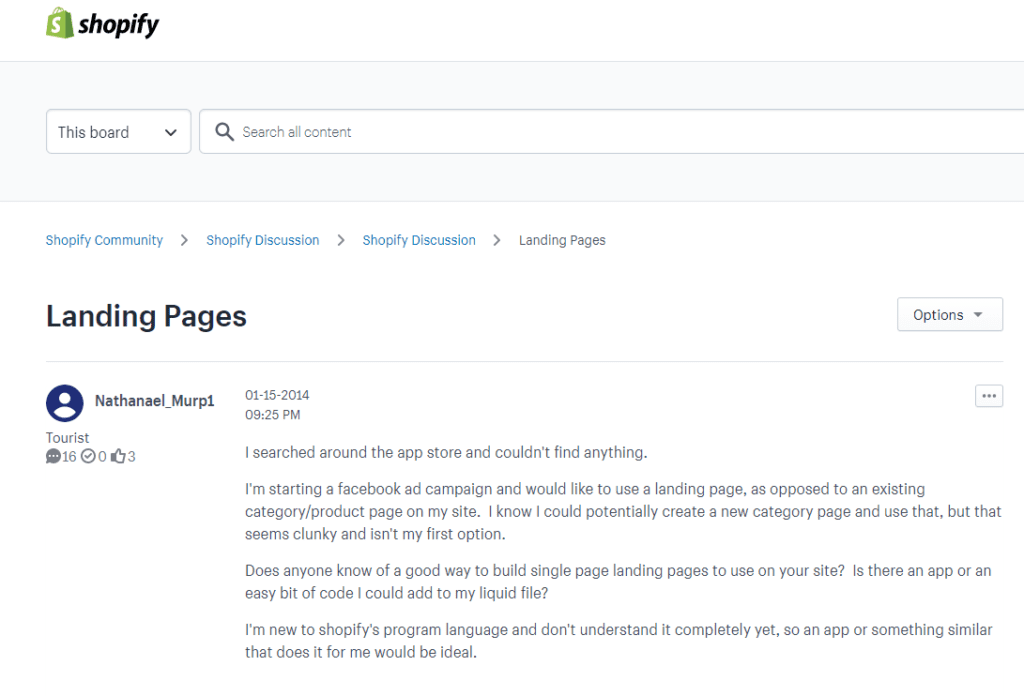
Since landing pages are such a crucial part of ecommerce, it would stand to reason that Shopify would make it easy for you to build them, right?
Wrong. You’ve got two options: hire a developer to code a template that you can use and edit later according to your campaigns. Or, the simpler alternative, invest in a third-party paid app like one from Shogun if you want to easily build landing pages for your Shopify website.
While Shopify has a great store builder, you’ll be disappointed if you want a drag-and-drop landing page builder.
Abandoned Cart Recovery
Research shows an average of 70% of abandoned online shopping cart rate in 2023. Customers will shop, place items in their cart, and leave the website without finishing the checkout process. As a result, abandoned cart recovery is a critical feature for any business. This feature is only available for your Online Store and Buy Button sales channels, but it makes it easier for you to reach out to those customers in an attempt to get them to come back and convert.
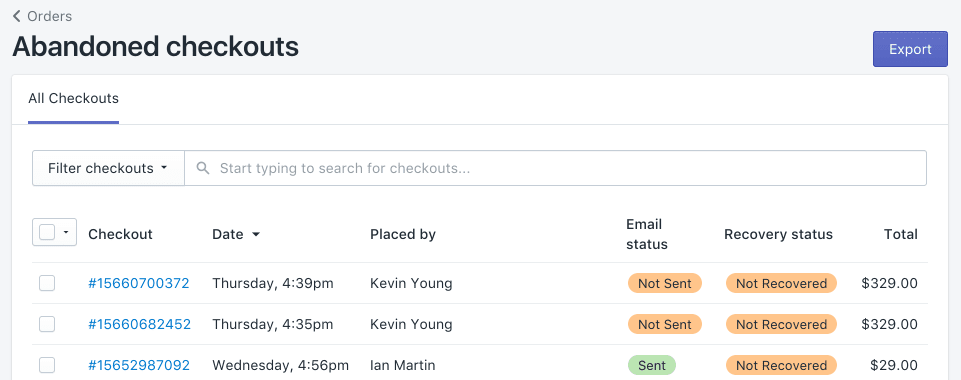
There’s a catch. This feature is only available on the Shopify and Advanced Shopify plans. Worse, it only allows you to send one email. A series of three would be more effective. Not only this, but Shopify dictates when you can send that email either 1, 6, 10, or 24 hours after cart abandonment. For more control, you will have to have yet another add-on. You can read more about Shopify abandoned cart recovery best practices here.
Coupons and Customer Loyalty
Shopify allows general discount codes and targeted campaigns. You can adjust the type of coupon or discount as well. You can choose both percentage and monetary discounts or shipping discounts. It only takes about 5 minutes to set up a discount.
Data shows that 65% of a company’s business comes from existing customers. When you consider this alongside the fact that loyalty program members spend between 12% and 18% more per year than non-loyalty program members, it makes sense to use one for your ecommerce business. By boosting customer retention by just 2%, you can reduce costs by as much as 10%.
If you want to build a customer loyalty program in your shop, the Shopify app store has a number of reward apps available, such as LoyaltyLion, Swell, Smile.io, and Beans. But this comes at an extra cost.
You could spend at least $300 per month with LoyaltyLion, or $49/month with Smile.io.
Each platform allows you to reward customers for a variety of actions, such as purchases, birthdays, social shares, etc., with points they can redeem for things like free products, free shipping, a percentage discount, or a dollar discount. Depending on which platform you choose, you may be able to craft a VIP program or reward people for referrals.
Shopify Ratings and Reviews Functionality
Research from Fan & Fuel shows that 94% of online customers read reviews before making purchasing decisions. And when it comes to product-specific information, data shows that 99.9% of shoppers read reviews before making a purchase.
Gone are the days where you could simply inform customers that a product or service is available. Now, customers want first-hand knowledge from people who have already used the product or shopped with a particular business. Failing to include reviews on your product is a missed opportunity.
Research from BrightLocal shows that in the United States, 68% of online shoppers are more likely to engage with businesses that have positive reviews, and 93% of people determine whether a business has a good reputation based on the available reviews. Fan & Fuel also reports that 92% of customers hesitated to make a purchase if there weren’t any customer reviews, and 97% of customers say that the reviews are part of their buying decisions.
If that’s not enough to convince you, Spiegel Research Center also reports that products with reviews are 270% more likely to be purchased compared to a product without. When it comes to a higher-priced product, the likelihood increases to 380%.
BrightLocal also reports that 76% of people trust online reviews as much as they trust recommendations from friends and family.
Though not included out-of-the-box, Shopify offers a free app, Product Reviews, to help shop owners increase sales and improve SEO. Once installed, you can add a customer review feature to all your products. You can easily customize the look and feel of ratings and reviews. The app supports schema markup so that an aggregate review score appears on your search results in Google to help increase traffic from organic search.
Website Search
You want your customers to be able to find what they’re looking for on your website, which means you need a good on-site search. Unfortunately, Shopify doesn’t deliver.
Both fuzzy and faceted search is important when it comes to an e-commerce website. People can’t spell, and they expect the search engine to figure it out. Google is good at that, but Shopify’s search engine isn’t. Even if they do spell things right but happen to make a typo, the search function may not be able to pull it up. It’s a shame to miss sales on a product your store carries just because the site search function doesn’t work well enough to help guide your visitors to it.
Keep this in mind if you want to sell several products. If all of the products you sell are clearly visible and easy to find, your website visitors may not be able to locate them. To address the issue, you can… you guessed it… head to the app store. You’ll find a few options that have a free plan available, but what you can do with that is limited compared to a paid plan.
Now that we have a pretty good idea of what Shopify can do for you – let’s take a closer look at performance – or how well it can do it.
Shopify Performance
In terms of performance, Shopify is one of the best. It’s the second-fastest platform I tested. Load speeds are fast on mobile, which goes a long way toward keeping customers’ attention where you want it: on your website.
| Platform | Performance | Load Time | Mobile Speed | Desktop Speed | Avg SEO Traffic |
|---|---|---|---|---|---|
| Shopify | 3.9 | 1.3 | 63 | 75 | 11717 |
| Sellfy | 3.1 | 1.4 | 46.8 | 72 | 134 |
| Zyro | 3.3 | 2.1 | 51 | 89 | 128 |
| Nexcess StoreBuilder | 4.0 | 1.93 | 53 | 72 | 58,645 |
| ShopWired | 4.3 | 1.38 | 56 | 80 | 717 |
| Pixpa | 2.3 | 1.6 | 22.66 | 65.5 | 72 |
| Freewebstore | 3.5 | 1.89 | 53 | 79 | 927 |
| Ecwid | 3.5 | 5.0 | 50 | 82 | 15,517 |
| Square Online | 2.8 | 2.03 | 1.0 | 3.0 | 65,317 |
| BigCommerce | 4.5 | 2.2 | 63 | 80 | 33626 |
| Woocommerce | 3.1 | 3.4 | 42 | 52 | 72968 |
| Shift4Shop | 3.0 | 2.8 | 50 | 58 | 9703 |
| Volusion | 2.9 | 3.5 | 48 | 56 | 15779 |
| Adobe Commerce | 2.8 | 4.8 | 39 | 43 | 19408 |
| Prestashop | 2.9 | 4.62 | 50 | 52 | 33851 |
| SquareSpace | 3.5 | 3.5 | 42 | 63 | 5678 |
| Wix | 3.9 | 3.2 | 69 | 81 | 543 |
| Weebly | 2.6 | 3 | 49 | 59 | 186 |
Load Time
Today’s consumers are more demanding than ever before. To retain customers and keep search engines happy, usability is crucial. Speed plays a major role in user satisfaction. One study showed that the stress response to delays in mobile speed is similar to that of solving a mathematical problem or watching a horror movie. The stress response is greater than waiting in the checkout line at a store.
When a site starts to load, there’s a period of time where users wait for that content to appear, and until that happens there’s no experience to speak of. The lack of experience is fleeting for fast connections, but on slower collections, users are forced to wait, and they may experience more issues as page resources come in.
When Pinterest reduced their perceived wait time by 40%, they saw a 15% increase in search engine traffic and sign-ups.
The BBC found that they lost an additional 10% of their users for every additional second their site took to load.
Shopify is one of the top-rated hosted platforms when it comes to loading time, which is crucial to success with any website, but especially ecommerce. My performance tests found that Shopify loads in an average of 1.3 seconds… and it’s no secret that high-performing sites engage and retain users better than low-performing ones.
BigCommerce, had the second-fastest load time in my research, with Adobe Commerce (formerly Magento) falling into the last place.
Retaining users is necessary for improving conversions. Slow sites negatively impact revenue, but fast bites have been shown to increase conversion rates.
For instance, Mobify sounds that every 100-millisecond decrease in home page load time translated to a 1.11% increase in session-based conversion. For them, this translated to an average annual revenue increase of nearly $380,000. They also found that a 100% decrease in their checkout page load time accounted for a 1.55% increase in session-based conversion which yielded an average annual revenue increase of nearly $530,000.
So, it literally pays to have a fast website.
Mobile Site Speed
In terms of mobile site speed, only Wix has Shopify beat. Why is this important? Mobile-friendliness and site speed are ranking factors Google and other search engines consider when determining where a site should rank for any particular search query.
Shoppers demand a fast and quality experience on mobile. Insider Intelligence research says that retail m-commerce (mobile e-commerce) sales will account for 43.4% of total retail e-commerce sales in 2023. We can expect this number to continue to grow as Millenials and Gen Zers, tech-savvy consumers, hold a great deal of spending power.
It’s forecasted that m-commerce will reach $710.42 billion by the end of 2025. With a compound annual growth rate (CAGR) of 25.5%, sales are expected to hit $488 billion, accounting for 44% of ecommerce in 2024.
Desktop Site Speed
When it comes to desktop speed, Shopify is a bit slower than Wix and BigCommerce, but still remains near the top. Though plenty of people are relying on their mobile devices to shop, there are still people who use their desktop computers to place orders.
The goal for any website owner is to produce a fast and frictionless experience regardless of which device a customer uses. Ideally, it shouldn’t matter whether a customer starts a transaction on their desktop and finishes it on a mobile app or vice versa. The experience should be seamless across all devices.
Average SEO Traffic
I used ranking data from Ahrefs to determine where each platform should rank in terms of the amount of traffic they get from the search engines. The more SEO-friendly the platform is, and the more SEO features it has available, the better it is because it makes it easier to get traffic.
Shopify falls into the middle of the pack here. I’ve made it no secret that the Shopify SEO features could use some improvement, and the data proves why. With something that is so lightning-fast and easy to use, it would be better for their users to have a great SEO experience, too.
Woocommerce takes the cake for this one, likely because it’s built for use with WordPress, which is a great platform in terms of its SEO-friendliness. Weebly has the lowest average SEO traffic, but that’s not really surprising. After all, Weebly doesn’t load nearly as fast as the others and is much slower in terms of mobile and desktop speed than most of the other platforms.
Shopify Integrations and Apps
Out of the box, Shopify allows you to offer product variants – different colors, styles, or sizes of a product without any hassle. There’s no need to add multiple pages for each variant. You can adjust prices and SKUs and show pictures of different variants within minutes.
It’s also possible to sell digital products right out of the box, too, but if you are selling personalized products, you’ll need a free app to help you there.
You can also use Shopify to sell your products on Facebook and Instagram, eBay, Amazon, and the Walmart Marketplace.
When connected, your products automatically sync to Facebook and Instagram to make creating ads and shoppable posts easier. And you can manage everything from within Shopify.
Connect Shopify to eBay to sell your products there and manage your orders from within Shopify. It’s free to install the eBay app, but you need an eBay Stores account that ranges from $24.95 to $349.95 a month, depending on the subscription tier you choose. You can check out a guide here.
If you want to increase your reach, you can integrate Shopify with the Walmart Marketplace. Once you’re approved, you can set things up for free, with no monthly subscription fees, while managing everything in Shopify.
Adding the Google Channel to your Shopify store will sync products and relevant information about your Shopify store with Google Merchant Center. This allows you to appear in relevant Google Shopping searches. Keep in mind that you must have a refund policy and terms of service on your store, along with your contact information (two contact methods, not including a contact form), to meet Google’s requirements. Connecting Google Analytics is also an option.
Shopify gives you the option to use a number of accelerated checkouts – Apple Pay, Google Pay, and PayPal. A benefit of using PayPal is that for U.S. or U.K.-based shoppers, buyer credit is available. Keep in mind, though, unless you also activate Shopify Payments, you’ll be charged a transaction fee every time people make a purchase using these payment methods.
Shopify Integrations and Plans
Strong Integration With Amazon
If you want to expand your online shop to Amazon to get in front of new customers, or you already use the FBA program to handle your shipping, Shopify may be the best choice for you. Why? Shopify worlds with Amazon in ways that other ecommerce carts just can’t.
Using the Amazon integration with Shopify, you can:
- Create new Amazon listings directly from within Shopify in various categories.
- Create offers for products that are already on Amazon directly from Shopify.
- Sync everything – product details, variants, and images to your Amazon Seller Central account
- Set pricing and reserve inventory just for your Amazon listings
- Link Shopify products with your existing Amazon listings in any category
For any of this to work, though, you have to have a professional seller account on Amazon, which will cost you $39.99 per month, in addition to other selling fees based on the product category.
Amazon Pay, otherwise known as Amazon Checkout, allows your customers to buy from your store using the payment and shipping information that’s already in their Amazon accounts. With this approach, you’ll maintain control of your customer relationships and won’t share any of the product-level data with Amazon.
Amazon 2-Way Sync ensures that everything remains up-to-date on both your Shopify and Amazon stores. This way, inventory sold from either store is accounted for in real-time to avoid overselling and running into stock issues.
Amazon Fulfillment By Amazon (FBA) allows you to ship inventory to various Amazon warehouse locations so that when a customer orders your product, it is packed and shipped on your behalf. You’ll be able to set the rates for Standard Shipping, Two-Day Shipping, and One-Day Shipping. You’ll need to add separate shipping rates for each of your shipping zones, and they must match the ease of the Amazon shipping rates.
When you use FBA, you’ll have fulfillment fees and inventory storage fees. These fees are based on the season and size of the item, along with the length of time they are stored. Fulfillment fees are based on weight and are charged per unit. There are fees for inventory return and inventory disposal, as well.
Fulfillment Integration
You won’t be disappointed with Shopify’s inventory management features and integrations. With Shopify, you can automatically send your orders to a fulfillment center, so you don’t have to worry about keeping inventory on hand and shipping yourself. This gives you more control over how fast you scale your business.
When choosing the right fulfillment center for your needs, remember your customer satisfaction will largely depend on the fulfillment company you choose – and they aren’t all created equally. Each provider offers different types of services.
You’ll need to consider the types of products you sell, your customers’ location, your monthly order volume, and how returns are handled.
Many fulfillment services offer Shopify integration, including:
- ShipBob
- ShipMonk
- FedEx Fulfillment
- Rakuten Super Logistics, and of course, FBA.
If you are a U.S.-based business with fewer than 2,000 SKUs that don’t sell any perishable or regulated products, and you ship anywhere from 10 to 10,000 orders every day, you can use the Shopify Fulfillment Network to keep stock in various warehouses across the country. Once the fulfillment centers receive inventory, they pick, pack, and ship your products when orders are placed.
If you find a fulfillment center that doesn’t have an official integration but who can process orders via email, you can create and activate a custom fulfillment service in your Shopify dashboard.
If they require more than an email, you’ll need a Shopify expert to build a custom app for you. For many ecommerce business owners, that’s a hassle, so it pays to use one that already integrates with Shopify.
Selling Online with Shopify
Shopify has some great selling features built-in, but if you want to use cross-selling or upselling to boost your revenue, you’ll need to invest in third-party apps to help you.
Cross-Selling and Upselling
Cross-selling involves presenting customers with products that are related to their original product. For example, if your customer puts a computer in their shopping cart, a cross-sell would be a printer.
Upselling, on the other hand, involves presenting customers with a product that’s slightly upgraded from their original choice. In the case of the computer, maybe it’s a faster processor, a bigger screen, or a bigger hard drive.
Why are cross-selling and upselling so important? Not only do they drive order value, but they also represent a decent amount of revenue for many businesses. You’ll need a paid app for more advanced selling features.
Abandoned Cart Recovery
The built-in abandoned cart recovery is a good place to start, but for greater control over the emails you send, or to send a series of emails, you’ll need an app to help you here, too. There are plenty to choose from, which give you control over how many emails you send, whether or not you use push notifications, and more.
Marketing Automation
Marketing automation is a crucial part of developing efficient workflows and processes within your business. According to Adobe’s State of Marketing Automation report, 98% of B2B marketers say that marketing automation is important to their success. And with good reason, too. Nucleus Research found that marketing automation returns $5.44 for every dollar spent.
Unfortunately, there is no built-in marketing automation in Shopify. But, the good news is that marketing automation apps are available in the Shopify marketplace. Shopify recommends using Kit. With it, you can set up and implement email marketing, and follow up on paid social media advertising campaigns. Using Kit Skills, you integrate Kit with other apps to allow it to do even more for you, such as:
- Accounting and invoicing
- SEO
- Promotional campaigns
- Remarketing
- Product discounts
- Leverage positive reviews
Product Reviews and User-Generated Content
The free product review app in the Shopify app store will make it easy for you to ask customers to leave product reviews. These are a type of user-generated content (UGC) that you can use to market your store. You can go beyond that functionality with additional apps, such as the Shopper Approved or YotPo app. It makes it easy to collect product reviews, photos, and more. The social proof Yotpo helps you display can help increase your sales. There is a free or extended trial plan available.
1-Click Selling
1-Click Selling is an easy way to simplify the purchasing process for your customers. If you want to add 1-click buying like Amazon, you can. Shop Pay, formerly known as Shopify Pay, is a process that makes it incredibly easy for shoppers to complete the checkout process. If your store uses the Shopify Payments payment gateway to accept credit cards, you’ll have access to this feature at no extra cost.

Shop Pay works by letting customers check out by entering a six-digit verification code that is sent directly to their phone. This way, you don’t have to enter any shipping or payment details to buy from you or from any other store on the Shopify platform.
This, of course, only works after shoppers have entered their shipping and payment information and opted to have it saved with Shop Pay. Checkout times are 40% faster, and conversion rates are up to 18% higher for returning customers.
Customer Support
Shopify Ping is another great feature. It’s a free mobile app for iOS and Android that helps you manage messages from your customers. Your store visitors can send you messages with Facebook Messenger, Shopify Chat, or Apple Business Cat. Then, all of those messages come to you through Shopify Ping to simplify the process for you. You can read and respond to messages from your mobile device, regardless of the platform the customer used to initially make contact.
As of May 2023, Shopify has over 8,000 apps in its app market. Take a look at some of the apps that extend the functionality of your store:
Shopify Templates and Design
When it comes to templates and design, Shopify makes it easy to build a high-quality design, but if you’re on a budget, you may be disappointed. The premium themes are quite costly and difficult to customize beyond what’s built in. That said, I found many of the premium themes still give people lots of freedom and flexibility for customization without needing to be a coding expert.
| Platform | Design & Themes | Visual Design | Mobile UX | Cost Of Premium Themes | # of Free Themes |
|---|---|---|---|---|---|
| Shopify | 4.0 | 5.0 | 97 | $140 | 9 |
| Sellfy | 5.0 | 5 | 93 | $0 | 5 |
| Zyro | 5.0 | 5.0 | 92 | $0 | 50+ |
| Nexcess StoreBuilder | 4.3 | 3.0 | 94 | $20-$100 | 4 |
| ShopWired | 4.3 | 5 | 93 | $3495+ | 20 |
| Pixpa | 4.3 | 5 | 94 | 0 | 131 |
| Freewebstore | 4.3 | 5 | 92 | 0 | 100+ |
| Ecwid | 4.3 | 5.0 | 93 | $60 | 1 |
| Square Online | 3.7 | 5.0 | 92 | $0 | 1 |
| BigCommerce | 3.8 | 5.0 | 94 | $150 | 12 |
| Woocommerce | 4.3 | 3.0 | 97 | $39 | 1000+ |
| Shift4Shop | 4.3 | 4.0 | 95 | $200+ | 50+ |
| Volusion | 3.7 | 4 | 92 | $180 | 18 |
| Adobe Commerce | 3.7 | 5.0 | 5 | $300+ | 1 |
| Prestashop | 3.2 | 4 | 94 | $29+ | 0 |
| SquareSpace | 4.3 | 5.0 | 5 | 100.00% | 14 |
| Wix | 4.7 | 5.0 | 92 | 0 | 72 |
| Weebly | 4.3 | 5 | 97 | $45 | 15 |
Theme Selection
The official Shopify theme store has a total of 136 themes to choose from as of May 2023, but only 12 are free. Compared to platforms like WordPress, where there are hundreds of thousands of options, this is fairly limited.
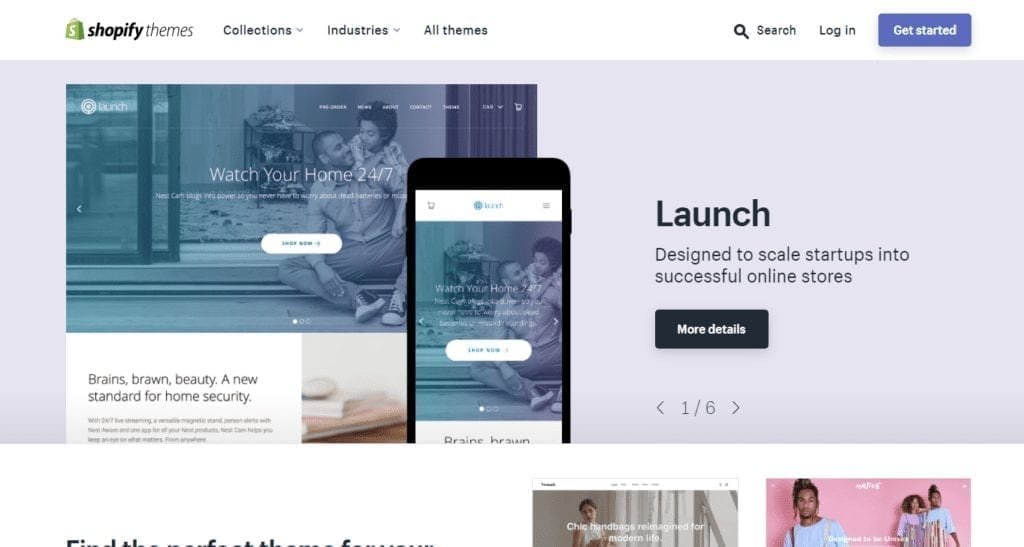
While customization is possible, in terms of adding your logo, adding a background image, and changing colors and fonts, when you break down the themes based on the number of products they are best for, stores with a medium catalog have the most options. If you’ve got a large catalog, you’ve really got two choices and a large catalog, you’ve really only got two. If you opt to choose based on your industry, at best, you have five themes to choose from.
When you consider that only nine of the themes in the Shopify repository are free, some store owners may want to allocate a portion of their budget to purchase a theme – either through the theme store or through a third party like ThemeForest. There’s no shortage of private-label Shopify themes available on the internet.
In terms of premium theme pricing, Shopify templates are fairly expensive. Even still, they are in the middle of the pack, with Wix and Prestashop being the most affordably priced, and Shift4Shop (formerly 3dcart) and Adobe Commerce being the most expensive. After you get your Shopify theme customized, you’ll want to remove the powered by Shopify from your footer.
Mobile User Experience
The good thing, regardless of the theme you choose – whether you opt for a free or paid choice from Shopify or a private-label option, you can be sure the themes load quickly and look amazing on mobile devices. Shopify ranks first in terms of the mobile user experience and has the highest possible score for visual design.
While Woocommerce and Weebly are tied with Shopify for mobile user experience, Woocommerce scores lower on visual design. If mobile ease of use is important to you, you’ll want to avoid Adobe Commerce and Squarespace, because they come in dead last.
Visual appeal is a crucial part of online sales because users make judgments about your brand and products based on what they see.
But, if you struggle to build something that looks good and is for you and your customers to use, is the platform really worth it?
Shopify Ease of Use
Shopify is easy to set up and easy for those with no technical background to use. If you’ve got the right theme and a few hours to work, you can be selling from your store and social media the same day.
That is, as long as you don’t need to change more than the template you choose allows. If you need to change more than you can with the theme, you’ll have to hire someone to help you or be a programming expert. If you decide to hire help, there are thousands of Shopify experts available to help. Compared to other platforms, that’s a huge advantage.
| Platform | Ease of Use | Phone Support | 24/7 Support | Chat Support | Community Rating | # of Apps/ Plugins |
|---|---|---|---|---|---|---|
| Shopify | 4.9 | Yes | Yes | Yes | 5 | 5,000 |
| Sellfy | 3.5 | No | Yes | No | 4 | 4 |
| Zyro | 3.7 | No | Yes | Yes | 4.7 | 30 |
| Nexcess StoreBuilder | 4.5 | Yes | Yes | Yes | 3.6 | 50,000+ |
| ShopWired | 4.5 | No | No | Yes | 4.9 | 72 |
| Pixpa | 3.7 | Yes | No | Yes | 4.7 | 103 |
| Freewebstore | 3.4 | No | No | Yes | None | 25+ |
| Ecwid | 3.6 | 5.0 | 1.0 | 5.0 | 4.7 | 100+ |
| Square Online | 4.0 | 5.0 | 1.0 | 5.0 | 4.2 | 25+ |
| BigCommerce | 4.8 | Yes | Yes | Yes | 4.0 | 1000 |
| Woocommerce | 3.3 | No | No | Yes | 4.0 | 250+ |
| Shift4Shop | 4.3 | Yes | Yes | Yes | 3.0 | ~250 |
| Volusion | 4.1 | Yes | Yes | Yes | 2 | ~20 |
| Adobe Commerce | 2.2 | No | No | No | 4 | 3000+ |
| Prestashop | 2.9 | Yes | No | No | 3 | 3000+ |
| SquareSpace | 3.8 | No | Yes | Yes | 3.0 | 10+ |
| Wix | 4.2 | Yes | Yes | No | 4.5 | 700 |
| Weebly | 3.6 | Yes | No | Yes | 2 | ~350 |
If you need help getting started, you can reach out to customer support any time, day or night, by phone, live chat, or email. You can call them at 1-888-746-7439 but expect a long wait time. The phone support is the best choice for you if you’re looking for a more immediate answer to your issue. Email responses can easily take 10 or more hours, and chat responses are typically 5 minutes or longer.
While several other platforms, including BigCommerce, Shift4Shop, Volusion, Prestashop, and Wix, offer phone support, you won’t find 24/7 support from all of them. Most of the platforms, with the exception of Prestashop, Wix, and Adobe Commerce, offer chat support.
Shopify has an international support base, but many users report the platform is better for US and UK-based merchants. It makes sense because that’s where the majority of their customers are based, but that doesn’t mean people in other countries should have a lesser experience.
Shopify’s platform is not only the easiest one I’ve tested, but it also comes highly rated by the community and has the largest app store. Adobe Commerce and PrestaShop come in tied for second but still have slightly more than half the number of apps you’ll find on Shopify. Volusion may rank pretty high in terms of overall ease of use, but it suffers because of a limited number of apps and plugins – the lowest of any on the list – and a low community rating.
Adobe Commerce is the one that really loses in this area. Not only is it the hardest platform to use, but there is also no phone support or chat support, let alone 24/7 support. You’re on your own with this one – or putting everything in the hands of an Adobe Commerce expert if you’re not a coding genius. And that’s okay because unless you’re able to build everything yourself and want a highly customized solution, Adobe Commerce isn’t something that should really be on your radar anyway.
Shopify Alternatives
If, as you’re reading this, you’re starting to realize Shopify may not be the best option for you, there are plenty of other website builders available for your store.
BigCommerce
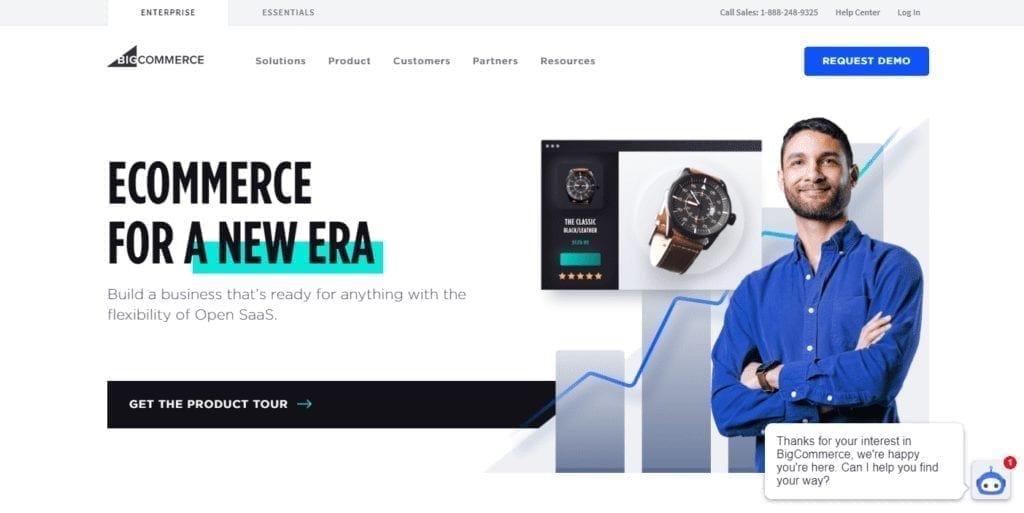
BigCommerce is an ideal choice for the majority of B2C businesses and companies with more extensive inventories. While there are no additional transaction fees with BigCommerce, Shopify offers two times more payment gateways than BigCommerce and about five times as many apps and plugins. Shopify offers 12 free themes, whereas BigCommerce offers 15 free options. Premium themes are priced comparably between the platforms, at $140 for Shopify and $150 for BigCommerce.
Ultimately, Bigcommerce has the most built-in features of any e-commerce platform included in our research. It beats Shopify in terms of SEO support and support for multi-channel selling. Even though Shopify can handle multi-channel selling there is a bit of a learning curve for users.
Wix
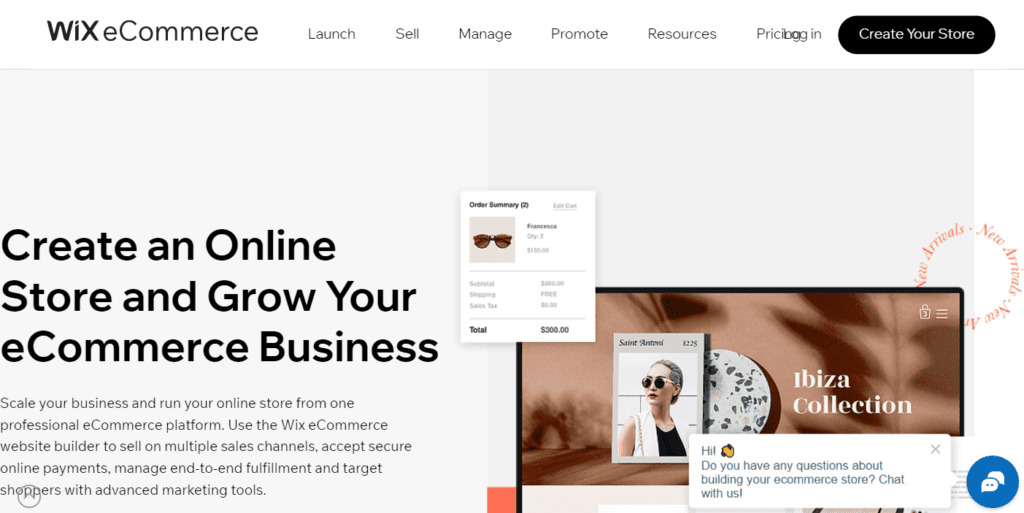
Both platforms score high overall, but the scores break down to reveal different strengths and weaknesses. Wix is a better solution for small businesses. Shopify can handle larger sales volumes and inventory.
Both Wix and Shopify began as a platform targeted at people with little to no experience coding. The difference between them is that Wix was built as a content website for blogs, news sites, portfolios, etc. Shopify offers more features and flexibility.
Wix is generally more affordable than Shopify since prices range from $23 to $49 per month. At that price point, why would you consider even the basic Shopify plan in its place? The additional features and ease of handling higher volumes may be enough to justify the extra expense for some businesses.
Sellfy
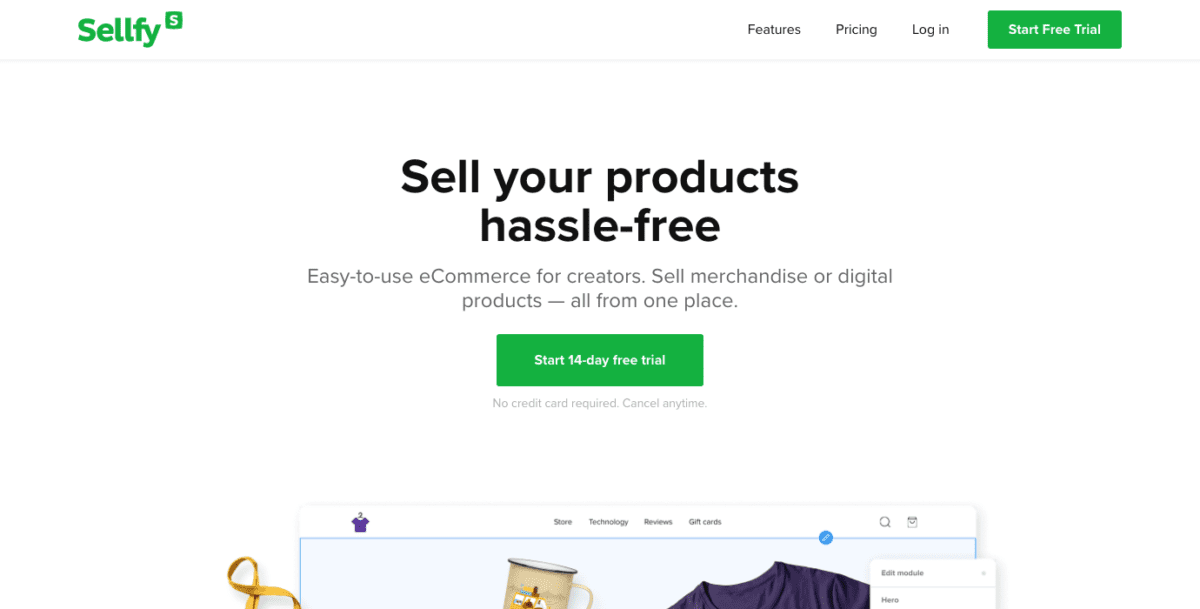
If you’re just getting started and have a limited budget, Sellfy may be a great Shopify alternative. You can get a store up and running in a matter of minutes. There’s no need to be a tech expert. That said, Sellfy does lack in terms of customization options. Really, the only things you can change are your logo and color scheme.
Once you get everything set up, your store can easily run itself thanks to automated payments and product downloads. It works with PayPal and Stripe payment gateways.
Pricing is comparable to Shopify and other ecommerce platforms on the market, with plans starting at $29/month with annual discounts.
WooCommerce
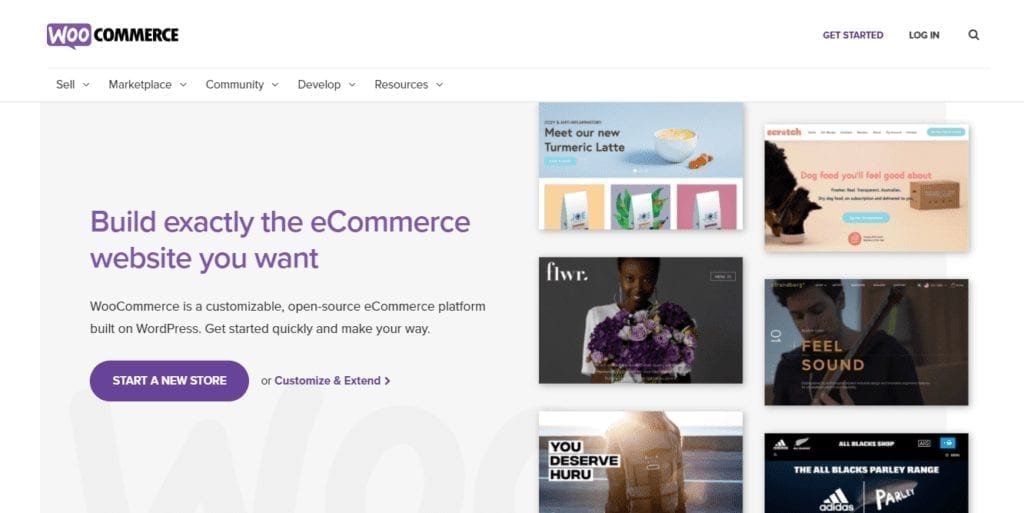
WooCommerce is a free plugin for WordPress to turn any WordPress website into a store. You’ll still need to pay for website hosting and domain registration. Depending on the hosting plan you choose, you may also need to purchase your SSL certificate. Before you can do anything with Woocomerce, you first have to install and configure WordPress.
When it comes to customization, WooCommerce offers more freedom, but it comes with a steeper learning curve than Shopify. You’ll have to find a Woocommerce theme, then spend time configuring various details, such as tax calculations and payment gateways.
Though there is a large WordPress community available to help you, there is still a learning curve particularly if this is your first WordPress website. With Shopify, all you have to do is create your account, choose and purchase your domain, or sync an existing domain and choose your theme. If you use Shopify Payments as your payment gateway it makes accepting credit card payments easy from the beginning.
Adobe Commerce
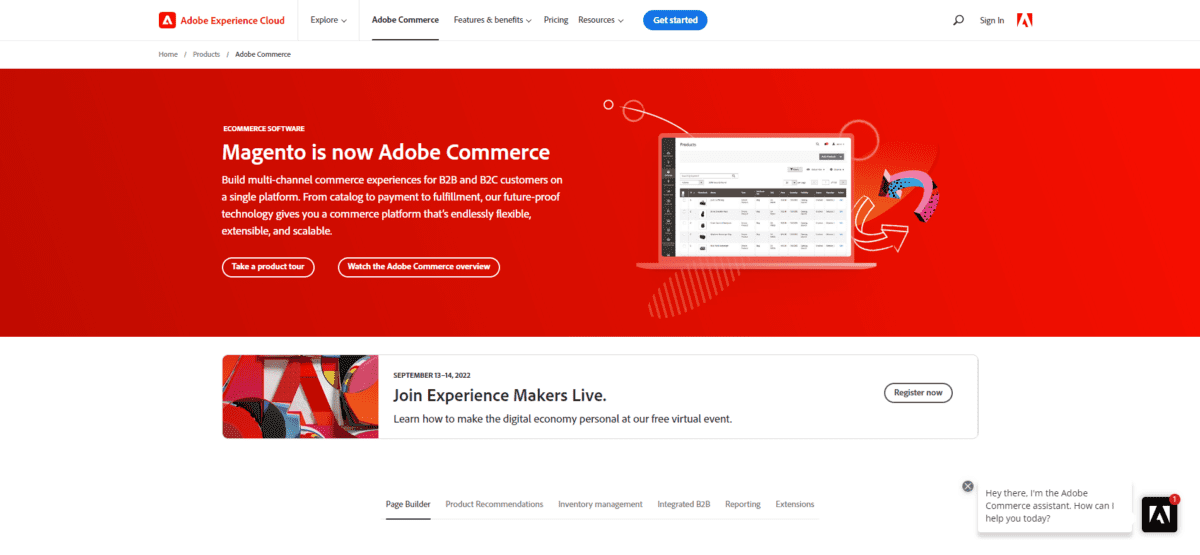
Adobe Commerce is an open-source platform similar to WordPress. However, Adobe Commerce is solely an ecommerce platform, whereas WordPress is predominantly a content management system. Adobe Commerce is powerful, but it will be difficult to reach your ecommerce goals if you don’t know how to code. Because of this, it is a better option for enterprise-level businesses that have their own development teams or can afford to outsource development.
As long as you know how to code, there are no limitations to how you can design your store. There is a large community of people available to help answer questions. It is not easy to install, and compared to other open-source software is more difficult to find a hosting provider that supports Adobe Commerce. Despite the fact that Adobe Commerce is far more flexible than Shopify, it comes with a steep learning curve, which is not ideal for people who want or need something easy to use.
Shopify Complaints
Most of the complaints around Shopify are about customer service. Like most bigger companies, your experience with customer service reps will vary. Sometimes you get a good one, and others, you get a bad one.
Shopify is no different.
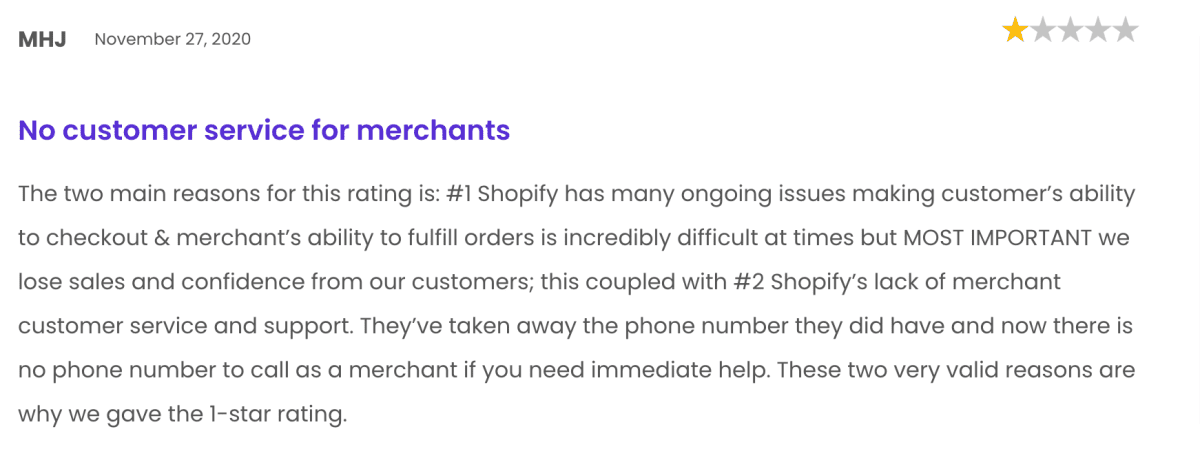
You can read the complaints and user reviews at the end of this post. You can also leave one.
Check out our full list of Shopify alternatives.
Shopify FAQs
Is Shopify Worth It? Here’s the bottom line
Shopify is a quality ecommerce solution for beginners with little to no experience with coding. It’s incredibly easy to use, and thanks to the themes out there, you can find a design that works well for your brand with relative ease. If you focus, you can easily have your store up and running over the course of a weekend. you
That said, it’s better suited for certain ecommerce business models. It’s a robust option for dropshipping services, small stores, and brick-and-mortar stores. With dropshipping integrations like Spocket and Amazon FBA, you can run a profitable store without ever having to keep stock or handle shipping. And by using it with the Shopify POS, you can centralize everything for your online and in-store orders, making it easier to manage inventory and staff.
However, subscription-based services will find it lacking. It’s incredibly expensive compared to other platforms because you need to use third-party paid apps to handle subscription billing. If you find that you’re spending too much money on apps every month to get all the features you need, it makes more sense to find a different platform that includes more of the features you need, even if it means paying a bit more to get things up and running because you’ll save more in the long run.
What it comes down to is the type of ecommerce business you’re running and how involved in the technical side of things you want to be. I really hope you enjoyed my Shopify review. Be sure to check out the other user reviews as well before deciding.
If you feel the time is right and Shopify is the best platform for your needs, click to get started. I have a Shopify tutorial that will walk you through the setup. I am a Shopify partner, which means that I do receive a commission if you sign up through my link. Or, check out the alternatives to learn more about other options.
If you have experience with Shopify, I’d love for you to leave a review to help others. Our goal is to have unbiased reviews, and we cannot do it without your help.
If you’re considering Shopify as an option, part of your research should be reading user reviews before making your decision. Our data and objective review summaries are here to help you, too.





